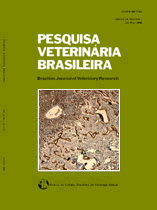 |
|
|
|
Year 2009 - Volume 29, Number 06
|

|
Detection of Pneumocystis in lungs of bats from Brazil by PCR amplification, p.469-473
|
ABSTRACT.- Cavallini Sanches E.M., Pacheco S.M., Cericatto A.S., Melo R.M., Colodel E.M., Hummel J., Bianchi S.P., Spanamberg A., Santurio J.M. & Ferreiro L. 2009. Detection of Pneumocystis in lungs of bats from Brazil by PCR amplification. Pesquisa Veterinária Brasileira 29(6):469-473. Setor de Micologia Veterinária, Faculdade de Veterinária, Universidade Federal do Rio Grande do Sul, Av. Bento Gonçalves 9090, Porto Alegre, RS 90540-000, Brazil. E-mail: cavallini.sanches@ufrgs.br
Pneumocystis has been isolated from a wide range of unrelated mammalian hosts, including humans, domestic and wild animals. It has been demonstrated that the genome of Pneumocystis of one host differs markedly from that of other hosts. Also, variation in the chromosome and DNA sequence of Pneumocystis within a single host species has been observed. Since information about the occurrence and nature of infections in wild animals is still limited, the objective of this work was to detect the presence of Pneumocystis sp. in lungs of bats from two states from Brazil by Nested-PCR amplification. The bats, captured in caves and in urban areas, were obtained from the Program of Rabies Control of two States in Brazil, Mato Grosso and Rio Grande do Sul, located in the Mid-Western and Southern regions of the country, respectively. DNAs were extracted from 102 lung tissues and screened for Pneumocystis by nested PCR at the mtLSU rRNA gene and small subunit of mitochondrial ribosomal RNA (mtSSU rRNA). Gene amplification was performed using the mtLSU rRNA, the primer set pAZ102H - pAZ102E and pAZ102X - pAZY, and the mtSSU rRNA primer set pAZ102 10FRI - pAZ102 10R-RI and pAZ102 13RI - pAZ102 14RI. The most frequent bats were Tadarida brasiliensis (25), Desmodus rotundus (20), and Nyctinomops laticaudatus (19). Pneumocystis was more prevalent in the species Nyctinomops laticaudatus (26.3% = 5/19), Tadarida brasiliensis (24% = 6/25), and Desmodus rotundus (20% = 4/20). Besides these species, Pneumocystis also was detected in lungs from Molossus molossus (1/11, 9.1%), Artibeus fimbriatus (1/1, 100%), Sturnira lilium (1/3, 33.3%), Myotis levis (2/3, 66.7%) and Diphylla ecaudata (1/2, 50%). PCR products which could indicate the presence of Pneumocystis (21.56%) were identified in DNA samples obtained from 8 out of 16 classified species from both states (5 bats were not identified). This is the first report of detection of Pneumocystis in bats from Brazil. |
| |
|
|
| |
|
 |